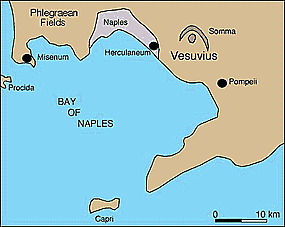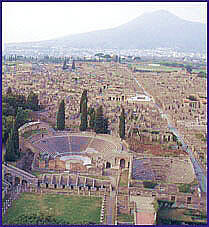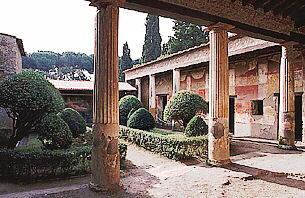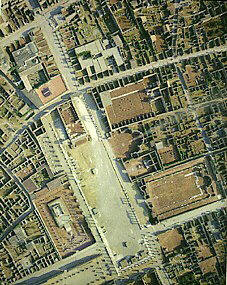|


|
Daily excursions:
Rome, Amalfi, Sorrento, Tuscany, Assisi |
|
TO BOOK
or to enquire: Please write to
info@romanhomes.com
We will reply to you swiftly. |
|
|
|
Tour of Rome |
Two days tour of Tuscany and Umbria: Siena, San Gimignano,
Pisa, Assisi
|
Amalfi and Sorrento | Assisi
Roman Castles: tour A, B, C, D and Grand Tour
|
|
|
|
►
Pompeii, Herculanum: presentation.
►
Daily excursion, prices.
Pompeii
was a resort
town inhabited by wealthy Romans who were known
for lavish spending on their homes. The fertile,
volcanic slopes of Vesevius provided an ideal
climate for grapes and olive groves. Since the
mountain had last erupted long before anyone
alive at the time had been born, people thought
that living near the most recognizable landmark
looming over the bay of Naples was completely
safe. The town had imposing temples, a beautiful
forum, perfectly built theater and stadium.
It was lunch time in August 79 AD when Vesuvius
began 19 hours of spectacular eruptions. |
 |
|
All the people in the
700-year-old town of 20,000 could have escaped.
There was time to flee. But no one recognized
the inherent danger of the mountain’s warnings. By
the time Vesuvius stopped belching poisonous
gas, the bustling city of Pompeii was silent,
completely buried by volcanic ash and debris. It
remained silent for 1700 years. Herculanum
underwent the same destiny. The eruption was the
first ever to be described in detail. |
|
|
 |
From 30 km (18
miles) west of the volcano, Pliny the Younger,
witnessed the eruption and later recorded his
observations in two letters. Volcanologists now
use the term "plinian" for the first stage of
devastating volcanic eruptions, in which dust,
ashes, cinders, and rocks erupt high into the
air, and in time settle back to Earth. This
stage may last for hours or even days. No lava
flows occur during the plinian stage. In areas
near the eruption, the amount of these materials
can be enormous. During the first eight hours of
the eruption of Vesuvius in 79 AD they fell on
Pompeii to depths of 2 to 4 meters (8-10 ft.). |
The heaps of
small rocks that landed on the houses caused
many roofs to collapse.
In the next stage of the eruption, a superhot
cloud of steam and mud (called "pyroclastic")
flowed down the side of Vesuvius and covered the
towns. At the speed of 30 mt. per second, it
took less than four minutes for the boiling mud
to flow from Vesuvius to Herculaneum, a distance
of about 7 kilometers (4 miles). |
|
About
3 meters (10 ft.) of ash and rocks fell on
Pompeii, burying everything except the roofs of
some buildings. The city was abandoned and its
location forgotten. In 1595, excavations
discovered artifacts at Pompeii and centuries of
pillaging followed. Archeological excavations
began in the mid-nineteenth century. Now, much
of Pompeii has been excavated and it has
revealed much about how people lived during that
time (and died during the eruption).
Herculaneum was
buried under 23 mts. (75 ft.) of ash. Once a
seaside resort with 5,000 inhabitans, the former
town became inland, and is now surrounded by the
modern city of Ercolano. |
 |
|
Silent for
thousands
of years, Pompeii and Herculaneum are now living
museums of life in the Roman Empire during the
first century of the Common Era. The sacrifice
and horrendous sufferings of its inhabitants
resulted in a generous gesture, as they donated
us the means to understand their architecture
and their culture, thus having an insight of the
ancient world otherwise impossible. Thanks to
the sacrifice of the inhabitants, we know their
habits, their customs, even their political
graffiti, or their love messages.
Surprisingly
sophisticated, Pompeii had a grid lay-out (right
photo). It had a three-stream running water
system. One stream went to public fountains,
another to public baths, and a third traveled to
homes of wealthy residents. People in Pompeii
even had a version of indoor plumbing, but they
did not have a good sewer system.
Flowing through
lead pipes from a central water tower (called
the Castellum Aquae), the water delivery system
was ingegnious for its day. When water supplies
were low, the town stopped the flow of water
streams in order of priority. First the wealthy
homes were without water, then the public baths.
Public fountains were shut down last. |
 |
| |
| |
| |
TO
BOOK or to enquire: Please write to
info@romanhomes.com We will reply to you
swiftly. Upon request we can organize your
transport to any other location or destination.
|
|
|
|
|
Visit
the other services we offer: |
Rome flying tours
|
Rome: Holiday
rentals |
Villas around
Rome |
Temporary
office |
|
Rental
enquiries |
Rome city
guide: maps.. |
Rome: longer
stays |
Roman
Homes additional services |
| |
|
|
|
|
ROMAN
HOMES® homepage
"Roman
Homes®"
and "Romecarservice®"
are registered trademarks.
All material of
this site, including text, images, and designs,
is property and copyright of Roman Homes®
/ Dr. Mauro Abate. It must not be copied,
modified, or duplicated in any part without
special permission from the owner. Legal steps
will be taken against those violating copyright,
registration and ownership rights.
|
|
|